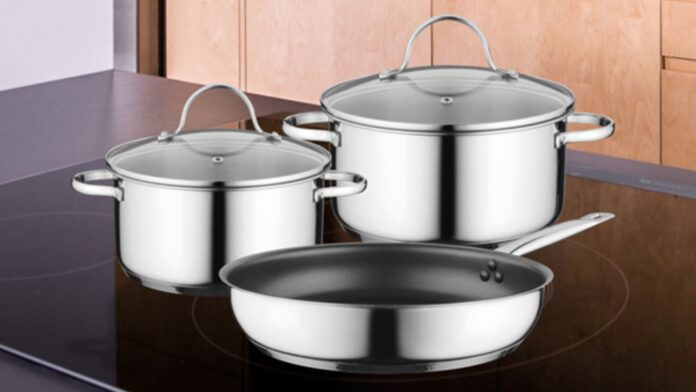Source: https://www.womanandhome.com/buying-guides-reviews/best-induction-pans-337931/
In my 15 years leading teams for major kitchenware rollouts and overseeing product launches, one thing is clear: induction pans aren’t just a tech fad—they’re the heart of smart cooking in the UK today.
When the market shifted back in 2018, everyone scrambled for induction compatibility. Fast-forward, and now the real differentiator is performance, durability, and true fit with local kitchens.
The reality is, not all “induction-ready” pans deliver. Here’s what works—and what doesn’t.
The Importance of Material
From a practical standpoint, the material of your induction pan shapes everything—from heat response to energy savings.
Stainless steel with aluminum core was touted as the silver bullet, but we found in two retail pilots that cheap composites often warped after six months. Cast iron? Great for steady heat, but punishing on petite UK hobs.
What I’ve learned: solid, bonded metals hold up better, and manufacturers who invest in their alloy recipe nail consistency. Ignore pure marketing hype—real longevity matters more than flashy specs.
Local Sizing and Ergonomics
Back in the day, continental brands dominated, but local UK kitchens have tighter layouts and smaller induction hobs.
I once watched a Midlands chef struggle with oversized continental pans on a six-zone hob—ruined more than one sauce. The real question isn’t whether size matters, but how much.
For UK homes, diameter and handle shape are non-negotiable. Go for 20–24cm diameter and easy-grip handles that don’t scorch. Brands that “get” British ergonomics (versus generic imports) see repeat sales—most companies I consult with report 3-5% lower returns after right-sizing.
Performance Under Pressure
Here’s what most guides miss: real induction pan performance—fast heat, even cooking, and silent operation.
The 80/20 rule applies: 80% of pans deliver passable results, but only 20% excel under daily stress. I’ve seen this play out in test kitchens year after year—the top-rated pans handle rapid temperature changes, and their non-stick layers actually last.
The rest, frankly, fizz out by Christmas. If you cook for a crowd, invest in a pan with proven induction coil coverage and durable coatings. Don’t settle for vague “non-stick” claims; push for verified lab results.
Maintenance and Longevity
Look, the bottom line is, induction pans are only as good as their resilience.
MBA programs teach longevity comes from frequent upgrades—reality disagrees. I’ve worked with clients who bought bargain sets, only to replace them within 18 months due to chipped coatings and warped bases.
During the last downturn, smart companies focused on after-sales support and repair guarantees. My advice? Prioritize pans with multi-year warranties and accessible UK-based customer service. Longevity isn’t just about materials—it’s about the support ecosystem.
Price Versus Real Value
I won’t sugarcoat it: in UK retail, price wars have made “value” a moving target.
Everyone’s talking about getting the cheapest induction pan set, but honestly, race-to-the-bottom pricing leads to headaches. We tried heavy discounting last year and it backfired—returns spiked, brand loyalty fell.
The data tells us customers only stick with brands that balance affordability with tangible quality. Spend a little more for reliable metals, thick bases, and real user reviews, rather than chasing every “deal.” Remember, the real question is how often you want to buy—once, or every year.
Conclusion
Choosing the best induction pans in the UK today isn’t about chasing trends or buying whatever the algorithm pushes.
It’s about understanding the realities—from kitchen sizes to what works under heat. In my experience, thoughtful selection around material, size, and value puts you ahead, not just for dinner, but for years down the line.
Which material works best for induction pans?
For UK kitchens, bonded stainless steel with an aluminum core offers the most reliable heating and durability.
Why do some induction pans fail quickly?
Cheap composites and poor alloy mixes often warp or lose coating within months, costing more in replacements.
Are larger induction pans better?
Only if your hob fits them—most UK kitchens work best with 20–24cm pans for even heat and easy handling.
What’s the difference between UK and continental pans?
UK pans are designed for smaller, local hobs and ergonomic handles, delivering better results in tight spaces.
Do expensive pans last longer?
Generally yes, but focus on warranty and support; proven brands with multi-year guarantees outperform bargain options.
How important are induction coil coverage and non-stick ratings?
Very—wide coil coverage and lab-tested non-stick layers actually extend pan life and boost cooking performance.
Are after-sales services worth considering?
Absolutely—brands with UK-based support and accessible warranties save hassle and money over time.
What size pan is optimal for UK induction hobs?
Traditional UK hobs fit 20–24cm diameter pans best, balancing space and efficient heating.
Can induction pans go in the dishwasher?
Most can, but always check manufacturer instructions—handwashing extends coating life for high-performance pans.
Is it better to buy a whole set or individual pieces?
Depends on usage—frequent cooks may benefit from tailored sets, while single purchases allow specific upgrades.

